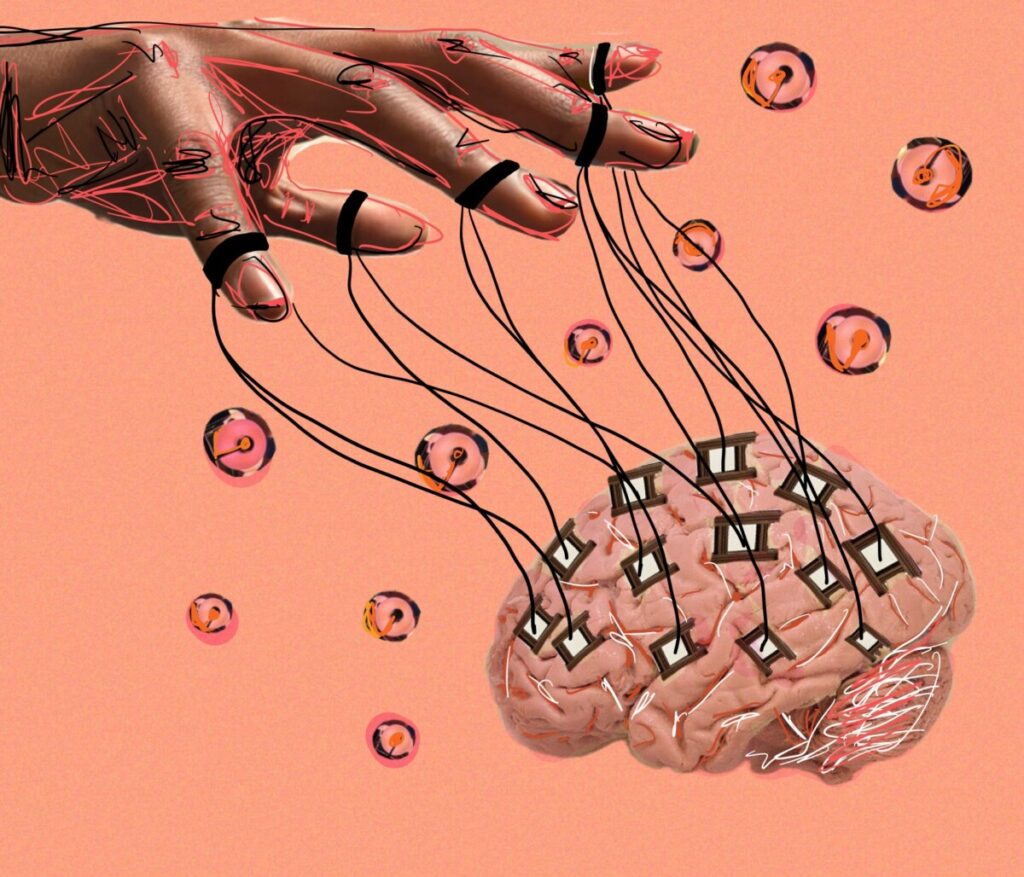by Sujay Edavalapati
art by Leia Marshall & Nicole Cobb with Dream AI

Everyone knows that one Marvel fanatic, whether it be your friend or your sibling, who has watched all of the movies three times over; this means you are likely familiar with Tony Stark’s beloved piece of augmented reality technology, J.A.R.V.I.S, from the Iron Man movies. J.A.R.V.I.S was designed by Tony Stark, who used his own thoughts to control the AI which gave him formidable power amongst the Avengers. What was only an idea to Stark materialized into reality as a result of his creativity. Although the Iron Man movies failed to explain how Stark was able to create such technology, it seems that the modern world found the solution without Stark’s help. As an idea first coined by researchers at Harvard University, the mechanism of biofeedback has taken the world by force [1]. However, instead of becoming a formidable military weapon like in the Marvel universe, biofeedback technology in the real world serves as one of the premier sources of information to understanding human physiology and disease.
Prescription drugs have been a longstanding vision of medical treatment in modern society. However, if the evolution of modern epidemiology has taught society anything, it is that medicine is never black and white. Hence, biofeedback provides an alternative approach to understanding certain diseases whereas prescription drugs may not either be effective or available at all. Biofeedback is the technique of using sensor-related data connected to an individual’s body to measure and monitor bodily processes and gather information for providers [2]. For example, neurofeedback, a form of biofeedback, is able to track information such as vitals through attachment of electrodes to the brain, which was one of the ways J.A.R.V.I.S. was able to process Stark’s vitals [3]. Stark was able to create a neural interface that connected to his armor, which allowed him to receive critical sensory and vital information during many of his important battles.
Now, biofeedback isn’t as convoluted as the Iron Man movies may have made it seem; in reality, it works in four main steps for the average user. The first step involves monitoring one’s vitals to collect data about average heart rate (HR), breathing rate, blood pressure (BP), pulse, and temperature to extremities . This information acts as a baseline for feedback and can give more insight to researchers what type of stress a particular patient is experiencing [4]. Notable physiological indicators of stress include higher HR, high BP, and lower temperature and sensation in extremities [5]. Individuals who use biofeedback therapeutically try to mitigate and relieve these stress indicators to help promote greater well-being.

After the collection of this data, a biofeedback technique is employed on patients. The biofeedback technique is specifically focused on receiving information about one’s own physiological data, which allows them or providers to understand further courses of action. A common misconception is that biofeedback refers to one specific technique that can be applied to all patients. However, biofeedback therapy falls within a larger subset of positive adaptive coping techniques, which are therapeutic activities that many people follow in their life without noticing. Some biofeedback techniques include progressive relaxation exercise, meditation, yoga, exercise, deep breathing, or even discussion of the issue [4]. The goal of implementing one of these exercises is to assess the vital information before, during, and after the technique to monitor fluctuations and provide positive feedback upon receiving the results. This leads into the second step, which is linking the data received to physiological processes in the human body. For example, if there is an increase in skin temperature, this is associated with increased blood circulation in the body. The third step is to channel that feedback signal as a learning tool towards improving physiological responses, which will allow an individual to control his or her body’s response to certain stimuli by changing thoughts, actions, or behaviors. For example, after receiving the feedback signal from the machine that their temperature levels are elevated, an individual can practice relaxing techniques such as slower and deeper breaths to increase blood flow throughout their body [4]. The last step is to prolong this response over weeks or months to gain greater control of the body’s physiological response, ultimately without the use of a biofeedback device, to help tackle stress and other harmful behaviors. While this treatment does not result in an immediate response, if done correctly, it can serve to have long-term, sustainable treatment benefits that can be more effective than medication [4].

Indeed, it has been shown that people who complete a biofeedback treatment sequence experience health benefits. In 2016, a study was performed amongst managers at a particular workplace dealing with stress, where subjects were told to keep a daily stress diary and would also wear wearable technology that detected changes in blood volume and heart rate over a five week period. Overall, subjects reported lower resting heart rate, less stress and anxiety, more energy, less fatigue, better health perception and social functioning [6]. Biofeedback has also been shown to improve those who have been struggling with mental health because it can be performed using wearable technology, or through unconventional methods like video games, to help regulate anxiety and stress levels and promote higher well-being [7]. At a biological level, biofeedback helps inhibit an increase in cortisol, a hormone induced by chronic stressors. This is why those who use biofeedback experience lower cortisol levels over the treatment period. The contributions of biofeedback are also prevalent in physical health like the use of EMG-feedback after knee surgery to help improve the knee’s range of motion or limb rehabilitation in elderly patients [8]. Yet, we can’t forget about its applications to neuroscience, can we? A form of biofeedback, neurofeedback, utilizes the brain’s neuroplasticity, or the ability of the brain to change its functionality over time, to help regulate homeostasis, mitigate disease, and strengthen the stability of the body [9].
Biofeedback has been generally regarded as a safe procedure but there are some risk factors like having certain heart rhythm problems or skin conditions [10]. Biofeedback has still not been tested for every condition, and there is not sufficient evidence currently to say that it will completely treat a disease but research is still ongoing at many institutions into gaining a better understanding of its applications and effects on numerous human diseases. Some key limitations to biofeedback research include too small of a sample size in studies as well as lack of consistency between treatment groups, which can occur due to difference in triggers and compliance between subjects [11]. However, future studies hope to compensate for these limitations by including longer treatment durations with larger sample sizes, more physiological parameters, a method to track the change in symptoms over the treatment, and a long-term follow-up appointment to record anxiety and physiological levels after the treatment [12].
Biofeedback has been an upcoming therapy technique in the medical field of the recent decades, and while its effects are still fully being studied, it has helped encourage a dramatic revolution in the way people view medical treatment. Current research has shown how instrumental a tool biofeedback has been in not only relieving a plethora of medical conditions but also its functionality for the average person in helping to mitigate detrimental stressors. Although modern biofeedback therapy must make significant strides to become as advanced as J.A.R.V.I.S., its clinical applications to th

